How to Sharpen a Knife: A Complete Guide
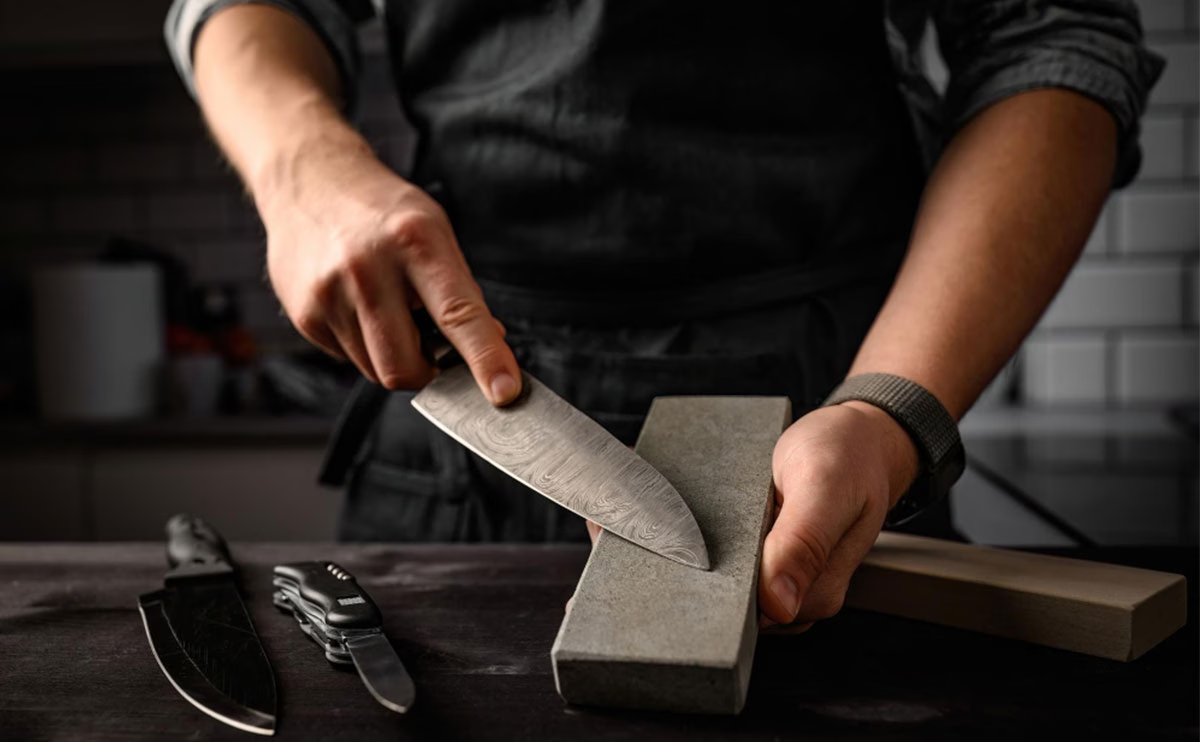
Knife sharpening is an essential skill every cook should master, whether you’re a professional chef or just someone who enjoys cooking at home. A sharp knife makes cutting, chopping, and slicing easier and safer, but not all knives stay sharp forever. Over time, your blade can lose its edge, making it more difficult to use. Knowing how to sharpen a knife properly will not only improve your culinary experience but also extend the life of your favorite knives.
In this guide, we’ll walk you through everything you need to know about sharpening a knife, including various methods, tools, and tips for achieving the sharpest edge. So, let’s dive in!
Signs That Your Knife Needs Sharpening
How to Recognize a Dull Knife
A dull knife is not just frustrating to use; it’s also dangerous. You’ll notice that a dull blade has trouble cutting through food, requires more force, and often causes the knife to slip or crush rather than slice. You might also notice that the knife feels “sticky” or “draggy” when cutting. If your knife starts to feel like this, it’s time to sharpen it.
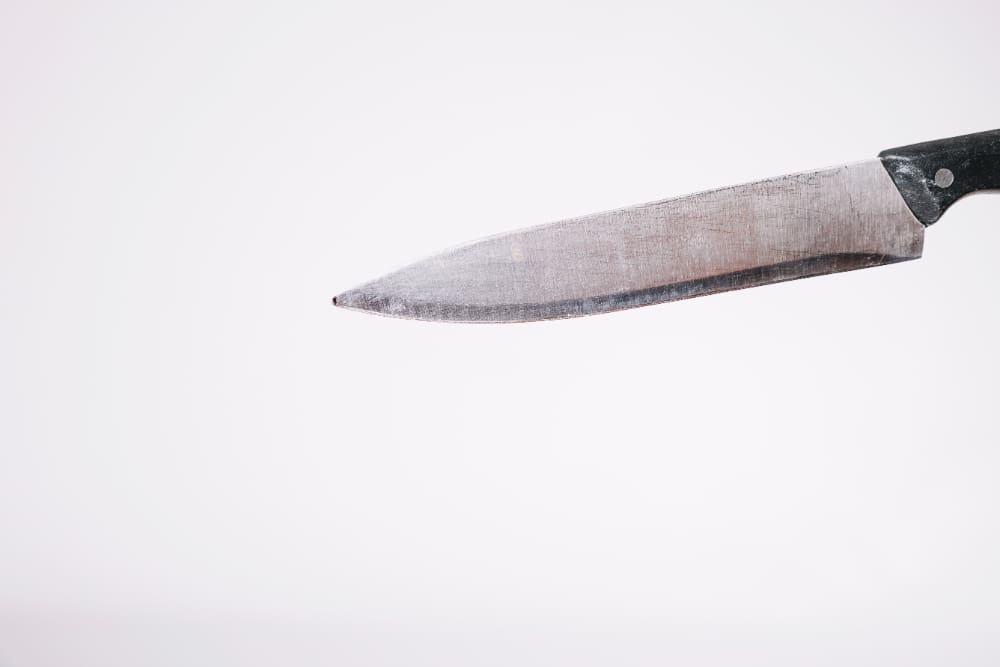
Importance of Regular Maintenance
Sharpening your knife regularly not only helps maintain its performance but also ensures that it stays in good condition for years to come. Regular honing, which helps realign the blade, can often prevent the need for frequent sharpening.
Understanding Knife Edges
The Anatomy of a Knife Blade
Before diving into the sharpening process, it’s important to understand what you’re working with. A knife consists of several parts: the handle, the blade, the spine (the top part), the edge (where the blade cuts), and the heel (the rear part of the blade). The edge is the area that you sharpen to restore the blade’s sharpness.
Different Types of Knife Edges
Not all knives have the same edge. Some blades are flat, while others may have a convex, V, or serrated edge. The sharpening technique can vary slightly depending on the type of edge you’re working with. For instance, a serrated knife requires a different sharpening method than a traditional straight-edged one.
Methods of Sharpening a Knife
There are several ways to sharpen a knife, each with its own pros and cons. Let’s break them down:
Using a Sharpening Stone
A sharpening stone, or whetstone, is the most traditional method. This method requires skill and patience but produces a fine edge. The stone is typically made from natural or synthetic materials and comes in various grits.
Using a Honing Rod
A honing rod doesn’t actually sharpen a knife but realigns the edge. It’s a quick and easy way to maintain your knife between full sharpenings. Regular use of a honing rod will help prolong the sharpness of your knife.
Using a Knife Sharpener (Electric and Manual)
Manual and electric sharpeners are easy to use and can get the job done quickly. These are great for beginners but may not offer the same precision as a sharpening stone.
Using a Leather Strop
A leather strop is used after sharpening to polish the blade and remove any microscopic burrs. It’s a great way to achieve a razor-sharp edge.
Step-by-Step Guide: How to Sharpen a Knife with a Sharpening Stone
Using a Sharpening Stone
Choosing the Right Grit for Your Stone
The grit of your sharpening stone determines how coarse or fine the stone is. Generally, sharpening stones come in a range of grits, and selecting the right one is crucial depending on the condition of your knife.
· Coarse Grit (200-600): Ideal for very dull knives with chips or serious wear.
· Medium Grit (800-1000): Great for knives that are dull but not severely damaged.
· Fine Grit (3000-8000): Used for polishing the blade and finishing a sharp edge.
For most kitchen knives, a medium grit (1000) is a good starting point. If your knife is in good condition, you can finish with a fine grit (3000 or higher).
The Correct Angle for Sharpening
The sharpening angle is essential for achieving the sharpest edge. Most kitchen knives require a 20-degree angle, which can be a bit tricky to achieve consistently.
· 20-degree angle: This is a standard for many kitchen knives, offering a good balance between sharpness and durability.
· 15-degree angle: This is sharper and better for finer cuts, but it can be less durable.
· Higher angles (25-30 degrees): These are used for heavy-duty knives like cleavers or utility knives.
To achieve the correct angle, either use a guide (if available) or manually maintain the angle by visualizing it or using your knuckles as a reference.
The Sharpening Process
1. Prepare your stone: Depending on whether you’re using a wet or oil stone, wet it with water or apply a small amount of honing oil to reduce friction.
2. Position the knife: Place the knife’s edge against the stone at the chosen angle (around 20 degrees).
3. Sharpen the blade: Use long, smooth strokes from heel to tip, applying even pressure. Push the knife across the stone as if you’re slicing through it.
4. Alternate sides: After a few strokes on one side, switch to the other side of the blade to ensure an even edge.
5. Check the edge: Periodically check the sharpness by feeling for a burr (a small ridge of metal that forms on the opposite side of the blade).
6. Polish the edge: Once the blade is sharpened to your satisfaction, use a finer grit to polish the edge.
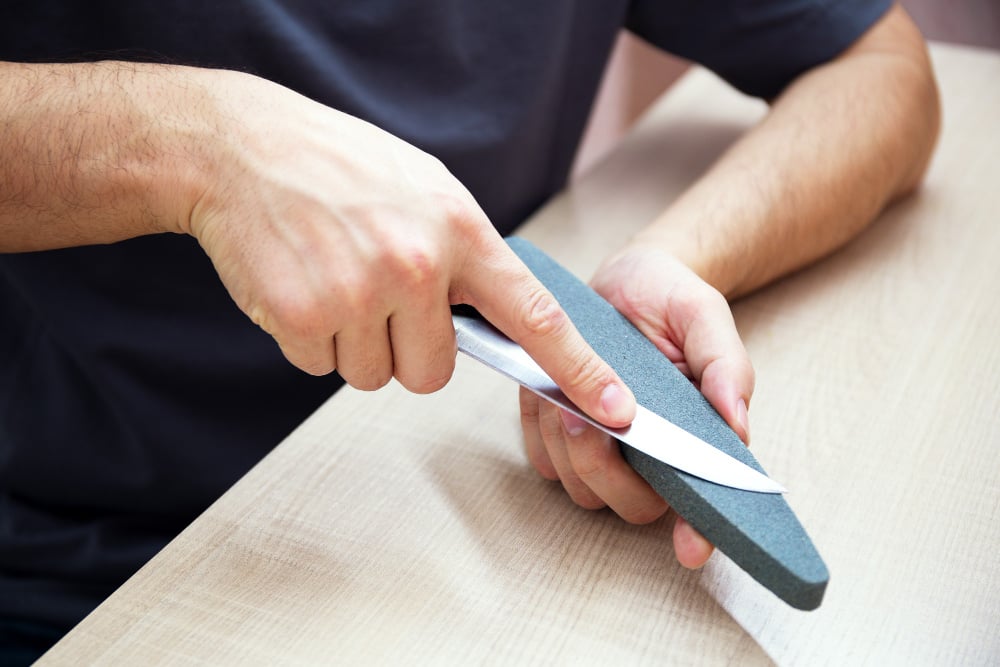
How to Use a Honing Rod
What is Honing and Why It’s Different from Sharpening
Honing realigns the microscopic teeth of the blade’s edge, while sharpening actually removes material to form a new edge. Honing doesn’t make a knife sharper in the traditional sense, but it helps to maintain the edge between sharpening sessions.
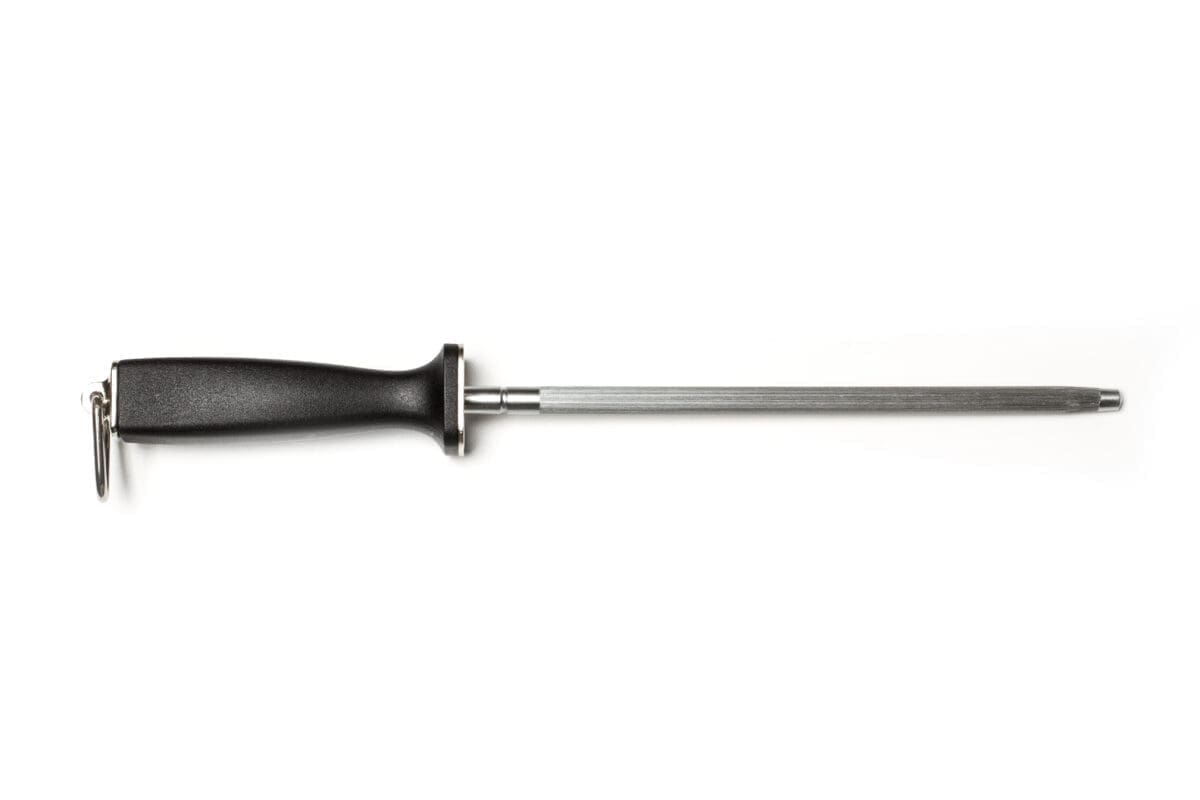
Proper Honing Technique
1. Position the honing rod: Hold the rod vertically with the tip resting on a firm surface or inside a stand.
2. Angle the knife: Hold the knife at a 15-20 degree angle to the rod.
3. Hone the knife: Gently draw the blade down the rod, starting from the base of the blade near the handle and ending at the tip. Repeat this process 5-10 times on each side of the blade.
4. Finish: Ensure the edge is evenly aligned by alternating sides until you feel the blade is realigned.
Using a Manual or Electric Knife Sharpener
Pros and Cons of Electric vs. Manual Sharpeners
Electric sharpeners are quick and easy to use. They are ideal for beginners and those who want a fast, consistent result, but they can remove more material than necessary and may not offer the finest precision.
Manual sharpeners are more hands-on and require a bit of skill, but they offer more control and precision over the sharpening process. They tend to be less aggressive on the blade and provide a more refined edge.

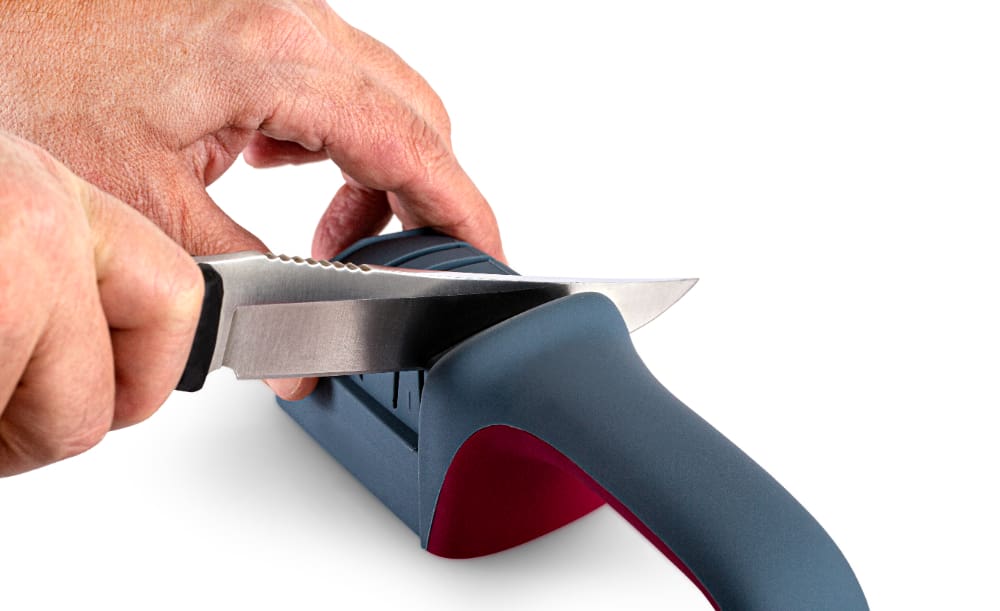
Step-by-Step Instructions for Using a Knife Sharpener
1. Position the knife: Place the knife in the sharpener’s slot. For electric sharpeners, turn the machine on and wait for it to be ready. For manual sharpeners, follow the instructions specific to the model.
2. Draw the knife through: Slowly draw the knife through the sharpening slots. For manual sharpeners, you may need to pull the knife through several times on each side.
3. Check the sharpness: Periodically check the blade to ensure it’s reaching the desired sharpness. Don’t overdo it to avoid removing unnecessary material.
Using a Leather Strop for Final Touches
What is a Strop and Why You Should Use One
A leather strop is a tool used to polish the blade after sharpening. It helps to remove small burrs (fine edges of metal) that might still be on the knife, resulting in a smoother, sharper finish.
How to Strop Your Knife for a Polished Edge
1. Apply polishing compound: Rub a small amount of polishing compound onto the leather surface of the strop.
2. Angle the knife: Hold the knife at a slight angle, usually around 15-20 degrees.
3. Strop the blade: Gently pull the blade along the leather, alternating sides. This step helps to give the blade a fine polish and a sharper edge.
4. Check for sharpness: After several passes, check the blade for a polished, razor-sharp edge.
Maintaining Your Knife’s Sharpness
Proper Storage of Knives
Proper storage helps maintain the sharpness of your knives. Avoid throwing knives in drawers where they can be damaged. Instead, use a knife block, magnetic strip, or knife sheath.
Cleaning and Drying Knives After Use
After each use, clean your knife with warm water and mild soap. Dry it immediately to prevent rusting. Never leave your knives submerged in water or wet for extended periods.
Common Mistakes to Avoid When Sharpening a Knife
Sharpening at the Wrong Angle
One of the most common mistakes is sharpening at the wrong angle, which can damage the edge. Always maintain a consistent angle, typically 20 degrees, and use a guide if necessary.
Using the Wrong Tools
Using the wrong sharpening tool, such as a coarse grit stone on a fine blade, can cause damage. Always choose the appropriate tool and grit for the job.
How Often Should You Sharpen Your Knife?
Frequency Based on Usage
If you use your knives every day, consider sharpening them every few months. However, if you’re a casual cook, sharpening once or twice a year might be enough.
Signs That Indicate It’s Time to Sharpen
If your knife starts to feel dull or unresponsive, it’s time for a sharpen. A dull knife is more dangerous than a sharp one, so don’t wait too long!
Conclusion: Mastering the Art of Knife Sharpening
Learning how to sharpen a knife properly will make your kitchen tasks easier, safer, and more enjoyable. Whether you choose to use a sharpening stone, honing rod, or electric sharpener, the key is consistency and attention to detail. With the right tools and techniques, you can keep your knives in top condition for years to come.
FAQs
1.Can I sharpen my knives at home without professional help?
Yes! With the right tools and a bit of practice, you can sharpen your knives at home.
2.How do I know if I’m using the correct angle when sharpening?
Most kitchen knives require a 20-degree angle, but it’s always best to check your knife’s specifications.
3.How often should I hone my knife?
Honing should be done every few uses to keep the blade aligned.
4.Can I use a sharpening stone for all types of knives?
Yes, sharpening stones can be used for most types of knives, but serrated knives require a different method.
5.What’s the difference between honing and sharpening?
Honing realigns the edge, while sharpening removes metal to create a new edge.
Related Post




